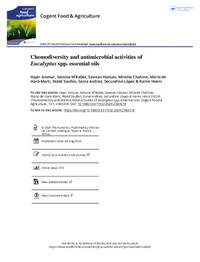Chemodiversity and antimicrobial activities of Eucalyptus spp. essential oils

Authors:
The essential oils extracted from the leaves of five Eucalyptus species: E. astringens, E. camaldulensis, E. lehmannii, E. leucoxylon, and E. sideroxylon, were investigated for their antimicrobial properties. These species were growing in the same plantation area, exposed to identical conditions, and subjected to uniform agronomic practices. Processed and analyzed under consistent parameters, the essential oil yields ranged from 0.14 to 0.96% (w/w). Chromatographic analysis were resolved into 48 compounds, with 11 common to all oils. Terpenoids (oxygenated mono- and sesquiterpenes) dominated the oil profiles, constituting 55.66–76.67% of the composition. Major components identified included 1,8-cineole (21.97–50.93%), α-pinene (2.18–15.95%), p-cymene (0.83–15.94%), spathulenol (0–20.49%), globulol (4.09–14.26%), and aromadendrene (2.37–15.03%). Genetically driven interspecific variation in composition was observed through Principal Component Analysis (PCA), Hierarchical Cluster Analysis (HCA), and heatmap clustering. Moreover, distinctive components were identified for each essential oil, offering a valuable tool for discriminating between Eucalyptus species and ensuring authentication and quality control in commercial samples. Results from antimicrobial disc-diffusion assays indicated robust antimicrobial activity in all essential oils, with those derived from E. camaldulensis, E. lehmannii, and E. leucoxylon exhibiting the highest effectiveness.
